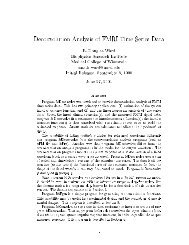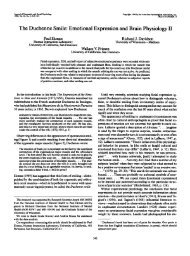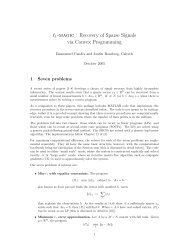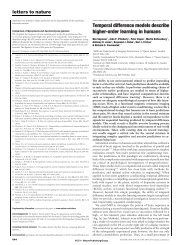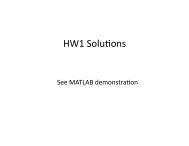Neural correlates of attentional expertise in long-term meditation ...
Neural correlates of attentional expertise in long-term meditation ...
Neural correlates of attentional expertise in long-term meditation ...
Create successful ePaper yourself
Turn your PDF publications into a flip-book with our unique Google optimized e-Paper software.
<strong>Neural</strong> <strong>correlates</strong> <strong>of</strong> <strong>attentional</strong> <strong>expertise</strong><br />
<strong>in</strong> <strong>long</strong>-<strong>term</strong> <strong>meditation</strong> practitioners<br />
J. A. Brefczynski-Lewis* † , A. Lutz*, H. S. Schaefer ‡ , D. B. Lev<strong>in</strong>son*, and R. J. Davidson* §<br />
*W.M. Keck Laboratory for Functional Bra<strong>in</strong> Imag<strong>in</strong>g and Behavior, Medical College <strong>of</strong> Wiscons<strong>in</strong>, University <strong>of</strong> Wiscons<strong>in</strong>, Madison, WI 53226; † Department<br />
<strong>of</strong> Radiology, West Virg<strong>in</strong>ia University, Morgantown, WV 26506; and ‡ Department <strong>of</strong> Psychology, University <strong>of</strong> Virg<strong>in</strong>ia, Charlottesville, VA 22904<br />
Edited by Edward E. Smith, Columbia University, New York, NY, and approved May 29, 2007 (received for review August 3, 2006)<br />
Meditation refers to a family <strong>of</strong> mental tra<strong>in</strong><strong>in</strong>g practices that are<br />
designed to familiarize the practitioner with specific types <strong>of</strong><br />
mental processes. One <strong>of</strong> the most basic forms <strong>of</strong> <strong>meditation</strong> is<br />
concentration <strong>meditation</strong>, <strong>in</strong> which susta<strong>in</strong>ed attention is focused<br />
on an object such as a small visual stimulus or the breath. In<br />
age-matched participants, us<strong>in</strong>g functional MRI, we found that<br />
activation <strong>in</strong> a network <strong>of</strong> bra<strong>in</strong> regions typically <strong>in</strong>volved <strong>in</strong><br />
susta<strong>in</strong>ed attention showed an <strong>in</strong>verted u-shaped curve <strong>in</strong> which<br />
expert meditators (EMs) with an average <strong>of</strong> 19,000 h <strong>of</strong> practice<br />
had more activation than novices, but EMs with an average <strong>of</strong><br />
44,000 h had less activation. In response to distracter sounds used<br />
to probe the <strong>meditation</strong>, EMs vs. novices had less bra<strong>in</strong> activation<br />
<strong>in</strong> regions related to discursive thoughts and emotions and more<br />
activation <strong>in</strong> regions related to response <strong>in</strong>hibition and attention.<br />
Correlation with hours <strong>of</strong> practice suggests possible plasticity <strong>in</strong><br />
these mechanisms.<br />
attention frontal parietal response <strong>in</strong>hibition<br />
In recent years <strong>in</strong>terest has been grow<strong>in</strong>g regard<strong>in</strong>g the neural and<br />
psychological effects <strong>of</strong> <strong>meditation</strong>. The present experiment<br />
exam<strong>in</strong>ed the neural basis <strong>of</strong> ‘‘one-po<strong>in</strong>ted concentration,’’ which is<br />
practiced to strengthen <strong>attentional</strong> focus and achieve a tranquil<br />
state <strong>in</strong> which preoccupation with thoughts and emotions is gradually<br />
reduced (1, 2). In this <strong>meditation</strong> one susta<strong>in</strong>s concentration<br />
on a small object or the breath without succumb<strong>in</strong>g to distractions<br />
(3). In addition, one engages <strong>in</strong> a process <strong>of</strong> self-monitor<strong>in</strong>g, <strong>in</strong><br />
which one notes mental states contrary to concentration, such as<br />
sleep<strong>in</strong>ess or ‘‘mental chatter.’’<br />
Studies have shown <strong>expertise</strong>-related changes <strong>in</strong> those pr<strong>of</strong>icient<br />
<strong>in</strong> <strong>meditation</strong> and other skills. Concentration <strong>meditation</strong> has been<br />
reported to improve performance on multiple components <strong>of</strong><br />
attention (4), decrease <strong>attentional</strong> bl<strong>in</strong>k (5), and improve the ability<br />
to control perceptual rivalry (6). In addition, changes <strong>in</strong> electroencephalogram<br />
and cortical thickness have been reported <strong>in</strong> <strong>long</strong><strong>term</strong><br />
<strong>meditation</strong> practitioners <strong>of</strong> compassion (7) and <strong>in</strong>sight <strong>meditation</strong><br />
(8). For other types <strong>of</strong> <strong>expertise</strong>, functional MRI f<strong>in</strong>d<strong>in</strong>gs<br />
vary depend<strong>in</strong>g on tra<strong>in</strong><strong>in</strong>g. For example, a study <strong>of</strong> short-<strong>term</strong><br />
object discrim<strong>in</strong>ation tra<strong>in</strong><strong>in</strong>g showed <strong>in</strong>creased activation <strong>in</strong> the<br />
work<strong>in</strong>g-memory network (9), whereas studies <strong>of</strong> <strong>long</strong>-<strong>term</strong> experts<br />
showed either <strong>in</strong>creased [musicians (10)] or decreased [golfers (11)]<br />
activation. Other studies showed an <strong>in</strong>verted u-shaped curve <strong>in</strong><br />
which those learn<strong>in</strong>g a skill <strong>in</strong>itially had <strong>in</strong>creased activation yet<br />
eventually showed less activation (12, 13).<br />
We studied expert meditators (EMs) with 10,000–54,000 h <strong>of</strong><br />
practice <strong>in</strong> two similar schools <strong>of</strong> the Tibetan Buddhist tradition.<br />
EMs were compared with age-matched novice meditators (NMs)<br />
with an <strong>in</strong>terest <strong>in</strong> <strong>meditation</strong> but no prior experience except <strong>in</strong> the<br />
week before the scann<strong>in</strong>g session, <strong>in</strong> which they were given <strong>in</strong>structions.<br />
To control for motivation, a second NM group, the <strong>in</strong>centive<br />
NMs (INMs), were <strong>of</strong>fered a f<strong>in</strong>ancial bonus if they were among the<br />
best activators <strong>of</strong> attention regions. Participants alternated a state<br />
<strong>of</strong> concentration <strong>meditation</strong> (Med.) with a focus on a small fixation<br />
dot on a screen, with a neutral rest<strong>in</strong>g state (Rest) <strong>in</strong> a standard<br />
block paradigm. To probe the <strong>meditation</strong>, we presented distract<strong>in</strong>g<br />
external stimuli (positive, neutral, or negative sounds) dur<strong>in</strong>g parts<br />
<strong>of</strong> the Med. and Rest blocks <strong>in</strong> an event-related design.<br />
Because concentration <strong>in</strong>volves focus<strong>in</strong>g attention, our first hypothesis<br />
was that Med. vs. Rest would result <strong>in</strong> activation <strong>of</strong><br />
attention-related networks and visual cortex to ma<strong>in</strong>ta<strong>in</strong> focus on<br />
the fixation dot (14–17). We further hypothesized that activation<br />
would vary among participants accord<strong>in</strong>g to a skill-related <strong>in</strong>verted<br />
u-shaped function <strong>in</strong> which NMs would have less activation than<br />
EMs with moderate levels <strong>of</strong> practice, but those EMs with the most<br />
practice would show less susta<strong>in</strong>ed activation because <strong>of</strong> less<br />
required effort (12, 13). Next, we predicted that, <strong>in</strong> Med., EMs<br />
would be less perturbed by external stimuli (sounds <strong>in</strong> Med.) and<br />
show less activation compared with NMs and INMs <strong>in</strong> bra<strong>in</strong> regions<br />
that are associated with task-unrelated thoughts (18), daydreams<br />
(19), and emotional process<strong>in</strong>g (20). Similarly we predicted that a<br />
decrease <strong>in</strong> distraction-related regions would correlate with EMs’<br />
hours <strong>of</strong> practice.<br />
Results<br />
Concentration Meditation Block Data. In the Med. block paradigm,<br />
participants performed concentration <strong>meditation</strong>, focus<strong>in</strong>g on a<br />
simple visual stimulus, alternat<strong>in</strong>g with a specific form <strong>of</strong> a neutral,<br />
rest<strong>in</strong>g state while bra<strong>in</strong> function was recorded with functional<br />
MRI. The patterns <strong>of</strong> significant activation for the Med. blocks vs.<br />
the Rest blocks are shown for EMs (see Fig. 1A) and NMs (Fig. 1B)<br />
on cortical surface models (21). EMs and NMs activated a large<br />
overlapp<strong>in</strong>g network <strong>of</strong> attention-related bra<strong>in</strong> regions, <strong>in</strong>clud<strong>in</strong>g<br />
frontal parietal regions, lateral occipital (LO), <strong>in</strong>sula (Ins), multiple<br />
thalamic nuclei, basal ganglia, and cerebellar regions (Tables 1 and<br />
2). Only NMs showed negative activation (Rest Med.) <strong>in</strong> anterior<br />
temporal lobe bilaterally (blue hues <strong>in</strong> Fig. 1B).<br />
As predicted <strong>in</strong> our hypothesis, <strong>in</strong> Med. vs. Rest, EMs showed<br />
greater activation than NMs <strong>in</strong> multiple <strong>attentional</strong> and other<br />
regions <strong>in</strong>clud<strong>in</strong>g frontoparietal regions, cerebellar, temporal, parahippocampal,<br />
and posterior (P.) occipital cortex, likely <strong>in</strong>clud<strong>in</strong>g the<br />
foveal visual cortex <strong>of</strong> the attended dot (red <strong>in</strong> Fig. 1C and Tables<br />
1 and 2). NMs showed more activation than EMs <strong>in</strong> medial frontal<br />
gyrus (MeFG)/anterior c<strong>in</strong>gulate (Acc) and <strong>in</strong> the right mid-Ins to<br />
Author contributions: J.A.B.-L. and A.L. contributed equally to this work; A.L., H.S.S., and<br />
R.J.D. designed research; J.A.B.-L., A.L., and R.J.D. performed research; J.A.B.-L., A.L., and<br />
D.B.L. analyzed data; and J.A.B.-L. and R.J.D. wrote the paper.<br />
The authors declare no conflict <strong>of</strong> <strong>in</strong>terest.<br />
This article is a PNAS Direct Submission.<br />
Freely available onl<strong>in</strong>e through the PNAS open access option.<br />
Abbreviations: Amyg, amygdala; DLPFC, dorsal lateral prefrontal cortex; EM, expert meditator;<br />
NM, novice meditator; INM, <strong>in</strong>centive NM; IFG, <strong>in</strong>ferior frontal gyrus; Ins, <strong>in</strong>sula; IPS,<br />
<strong>in</strong>traparietal sulcus; LO, lateral occipital; LHEMs, EMs with the least hours <strong>of</strong> practice;<br />
MHEM, EMs with the least hours <strong>of</strong> practice; MeFG, medial frontal gyrus; Acc, anterior<br />
c<strong>in</strong>gulate; Med., <strong>meditation</strong>; P., posterior; P. C<strong>in</strong>g, P. c<strong>in</strong>gulate; ROI, region <strong>of</strong> <strong>in</strong>terest; SFG,<br />
superior frontal gyrus; MFG, middle frontal gyrus.<br />
§ To whom correspondence should be addressed at: W. M. Keck Laboratory for Functional<br />
Bra<strong>in</strong> Imag<strong>in</strong>g and Behavior, Waisman Center, University <strong>of</strong> Wiscons<strong>in</strong>, 1500 Highland<br />
Avenue, Madison, WI 53705. E-mail: rjdavids@wisc.edu.<br />
This article conta<strong>in</strong>s support<strong>in</strong>g <strong>in</strong>formation onl<strong>in</strong>e at www.pnas.org/cgi/content/full/<br />
0606552104/DC1.<br />
© 2007 by The National Academy <strong>of</strong> Sciences <strong>of</strong> the USA<br />
NEUROSCIENCE<br />
www.pnas.orgcgidoi10.1073pnas.0606552104 PNAS July 3, 2007 vol. 104 no. 27 11483–11488
Fig. 1. Meditation block data. Activation <strong>in</strong> concentration <strong>meditation</strong> block<br />
(Med.) vs. rest<strong>in</strong>g state block (Rest) for 12 EMs (A), 12 age-matched NMs (B), and<br />
t test subtraction <strong>of</strong> EMs (C) (red hues reflect greater activation <strong>in</strong> EMs vs. NMs) vs.<br />
regular NMs (blue hues reflect greater activation <strong>in</strong> NMs vs. EMs). Alpha maps<br />
rang<strong>in</strong>g from P 0.001 (orange, positive activation; medium blue, negative<br />
activation) to P 0.01 (orange/medium blue) to P 0.05, corrected (red, positive<br />
activation; dark blue, negative activation) are overlaid on <strong>in</strong>flated populationaverage,<br />
landmark- and surface-based atlas cortical model bra<strong>in</strong>s and an axial<br />
slice at z 11 to show midbra<strong>in</strong> regions. ‡, smaller than corrected for multiple<br />
comparisons. (D) Activation <strong>in</strong> attention-shift<strong>in</strong>g metaanalysis ROIs. Color scale is<br />
the same for all panels (see key). (E) Response over time (seconds) for left DLPFC.<br />
Start <strong>of</strong> the <strong>meditation</strong> block is <strong>in</strong>dicated by an orange l<strong>in</strong>e at 80 sec. Standard<br />
error bars are shown for every 10 sec. (F) Bar graphs for amplitude <strong>of</strong> activation<br />
<strong>in</strong> DLPFC <strong>in</strong> the ‘‘early’’ part <strong>of</strong> the <strong>meditation</strong> block (the first 10 sec, exclud<strong>in</strong>g the<br />
first 2 sec because <strong>of</strong> hemodynamic delay) and the ‘‘late’’ part <strong>of</strong> the <strong>meditation</strong><br />
block (120 sec to 200 sec).<br />
P. Ins (Fig. 1C and Table 3), regions that have been shown to<br />
negatively correlate with performance <strong>in</strong> a susta<strong>in</strong>ed attention task<br />
(16, 22).<br />
We were concerned that these differences may have resulted <strong>in</strong><br />
part from structural differences between participant-group bra<strong>in</strong>s,<br />
because seven <strong>of</strong> 12 EMs were Asian (five Caucasian), and all NMs<br />
were Caucasian. Therefore, we performed a separate analysis <strong>in</strong><br />
which structural differences were taken to account by us<strong>in</strong>g probability<br />
<strong>of</strong> gray matter maps as voxel-wise covariates <strong>in</strong> a t test<br />
comparison between groups (23). All significant regions rema<strong>in</strong>ed<br />
significant <strong>in</strong> this analysis, and several regions just below threshold<br />
became larger and thus survived multiple correction [support<strong>in</strong>g<br />
<strong>in</strong>formation (SI) Fig. 3A]. In addition, we were concerned with<br />
possible motivation differences between groups. Therefore, to<br />
better match motivational arousal, we collected data from a set <strong>of</strong><br />
10 INMs who were told they would receive a monetary award ($50)<br />
if they were <strong>in</strong> the top one-third <strong>of</strong> the INMs <strong>in</strong> activat<strong>in</strong>g<br />
attention-related regions.<br />
We exam<strong>in</strong>ed all participant groups, <strong>in</strong>clud<strong>in</strong>g the INMs, us<strong>in</strong>g a<br />
priori regions <strong>of</strong> <strong>in</strong>terest (ROIs) from a metaanalysis <strong>of</strong> 31 studies<br />
<strong>in</strong>volv<strong>in</strong>g attention-shift<strong>in</strong>g paradigms (24). The EMs showed significantly<br />
more activation (two-tailed t test) than NMs <strong>in</strong> all<br />
attention ROIs except the thalamus (red vs. dark blue <strong>in</strong> Fig. 1D).<br />
However, the INMs (light blue) showed more activation than the<br />
NMs and were not significantly different from the EMs <strong>in</strong> these<br />
ROIs. In the t test <strong>of</strong> EMs vs. INMs, EMs had more activation <strong>in</strong><br />
the left superior frontal gyrus (SFG)/middle frontal gyrus (MFG),<br />
and INMs had more activation <strong>in</strong> left P. Ins, left <strong>in</strong>ferior frontal<br />
gyrus (IFG), and LO (SI Fig. 3 B and C and Table 2).<br />
Next, because we predicted that these results would correlate<br />
with hours <strong>of</strong> practice, we split the EM group <strong>in</strong>to those with the<br />
most hours <strong>of</strong> practice (top four MHEMs, mean hours 44,000,<br />
range 37,000–52,000, mean age 52.3 years) and those with the least<br />
hours <strong>of</strong> practice (lower four LHEMs, mean hours 19,000, range<br />
10,000–24,000, mean age 48.8 years, youngest participant not<br />
<strong>in</strong>cluded to ensure age-match<strong>in</strong>g). Two Asians and two Caucasians<br />
were <strong>in</strong> each group. Consistent with an <strong>in</strong>verted u-shaped function,<br />
we found that the LHEMs (brown) had the strongest activation,<br />
significantly higher than both sets <strong>of</strong> NMs <strong>in</strong> all attention ROIs<br />
except left <strong>in</strong>traparietal sulcus (IPS) and LO (SI Fig. 3D) and<br />
significantly higher than MHEMs (orange) <strong>in</strong> all ROIs except LO.<br />
Results were not significantly different when the top five MHEMs<br />
were used (rather than the top one-third; data not shown) nor when<br />
the youngest LHEM was used (mak<strong>in</strong>g mean age 42.3 years), except<br />
<strong>in</strong> thalamus ROI, <strong>in</strong> which LHEMs were not significantly different<br />
(same trend) from INMs or MHEMs (the thalamus ROI was more<br />
posterior than the thalamus cluster activated <strong>in</strong> our study).<br />
In addition, we performed correlations with hours <strong>of</strong> practice<br />
with<strong>in</strong> the EM group. Because age was a potential confound, we<br />
calculated the correlation between a participant’s age and hours <strong>of</strong><br />
practice. This was not significant (r 0.22, P 0.44), but it had a<br />
positive trend <strong>of</strong> older participants hav<strong>in</strong>g more hours. Thus, we list<br />
partial r values for activation vs. hours <strong>of</strong> practice, account<strong>in</strong>g for<br />
age. Many regions, <strong>in</strong>clud<strong>in</strong>g those <strong>in</strong> the attention network, showed<br />
significant negative correlation with hours, whereas no regions<br />
showed positive correlation with hours (see last columns <strong>of</strong> Tables<br />
1 and 2, SI Table 4, and SI Fig. 4A), consistent with the view that<br />
<strong>expertise</strong> may lead to decreased activation, possibly because <strong>of</strong><br />
<strong>in</strong>creased process<strong>in</strong>g efficiency. The notion <strong>of</strong> <strong>in</strong>creased process<strong>in</strong>g<br />
efficiency <strong>in</strong> <strong>long</strong>-<strong>term</strong> practitioners is consistent with recent evidence<br />
from our laboratory us<strong>in</strong>g another task, the <strong>attentional</strong> bl<strong>in</strong>k<br />
task, where we found that a 3-month period <strong>of</strong> <strong>in</strong>tensive <strong>meditation</strong><br />
led to decreased amplitude <strong>of</strong> the late component <strong>of</strong> the eventrelated<br />
potential to an <strong>in</strong>itial target, a marker <strong>of</strong> <strong>in</strong>creased process<strong>in</strong>g<br />
efficiency that predicted improved behavioral performance<br />
on a subsequent target (5).<br />
We reasoned that if these results could be expla<strong>in</strong>ed by differences<br />
<strong>in</strong> the amount <strong>of</strong> effort required to ma<strong>in</strong>ta<strong>in</strong> <strong>attentional</strong> focus<br />
with <strong>expertise</strong>, one should see differences <strong>in</strong> the time courses <strong>of</strong> the<br />
hemodynamic response. In the left dorsal lateral prefrontal cortex<br />
(DLPFC) ROI, MHEMs had only a short activation period at the<br />
beg<strong>in</strong>n<strong>in</strong>g <strong>of</strong> the Med. block (P 0.02) that returned to basel<strong>in</strong>e<br />
with<strong>in</strong> the first 10–20 sec (significantly less than the LHEMs; P <br />
0.001). In contrast, LHEMs had a larger, susta<strong>in</strong>ed response over<br />
the duration <strong>of</strong> the block (Fig. 1E). This short vs. susta<strong>in</strong>ed response<br />
contributed <strong>in</strong> part to the decreased activation for MHEMs vs.<br />
LHEMs <strong>in</strong> the attention-related ROIs (Fig. 1D) because the<br />
hemodynamic response function we used <strong>in</strong> our analysis modeled<br />
a cont<strong>in</strong>uous response over the entire block. ‘‘Meditation startup’’<br />
<strong>in</strong>creases occurred <strong>in</strong> most attention ROIs except for the thalamus<br />
and left anterior Ins and were also seen <strong>in</strong> right fusiform gyrus and<br />
bilateral caudate. Several other types <strong>of</strong> responses were seen <strong>in</strong><br />
MHEMs, <strong>in</strong>clud<strong>in</strong>g suppression <strong>in</strong> regions like MeFG/Acc and P.<br />
Ins and more susta<strong>in</strong>ed responses <strong>in</strong> IPS, LO, <strong>in</strong>ferior occipital,<br />
SFG, and MFG (regions with activation <strong>in</strong> last 80 sec <strong>of</strong> Med.) [SI<br />
Fig. 3E (P 0.05 uncorrected); also see representative time course<br />
plots <strong>in</strong> SI Fig. 4B]. The left SFG/MFG region overlapped with the<br />
only region that was significantly greater <strong>in</strong> the 12 EMs vs. INMs<br />
(compare SI Fig. 3 C and E; see also Table 2).<br />
If the hemodynamic time course is <strong>in</strong>fluenced by effort, one<br />
should also see a more susta<strong>in</strong>ed response <strong>in</strong> the highly motivated<br />
INMs compared with the regular NMs. Indeed, INMs had a greater<br />
susta<strong>in</strong>ed response than the NMs <strong>in</strong> which activation at times fell<br />
with<strong>in</strong> basel<strong>in</strong>e levels. However, both NM groups had reduced<br />
11484 www.pnas.orgcgidoi10.1073pnas.0606552104 Brefczynski-Lewis et al.
Table 1. Meditation block data: Bra<strong>in</strong> regions differentially activated for EMs vs. NMs<br />
ROI<br />
Volume,<br />
mm 3<br />
Talairach<br />
coord<strong>in</strong>ates,<br />
x, y, and z<br />
EM<br />
t value<br />
NM<br />
t value<br />
EM vs. NM<br />
t value<br />
EM hours<br />
partial r value<br />
EMs NMs<br />
Frontal<br />
Left MFG/IFG, BA45, 46 1,355 49, 29, 19 4.4** 0.77 3.2*** 0.72**<br />
Right SFG, BA9 1,009 31, 42, 31 2.9** 0.02 2.4* 0.47<br />
Left supplementary motor area, MFG, DLPFC, BA9, BA32 924 21, 6, 50 3.3** 1.0 2.5* 0.63*<br />
Left rectal gyrus, BA11 811 0.5, 43, 26 3.8*** 1.9 3.4*** 0.32<br />
Left precentral, DLPFC, BA6 1,535 34, 2, 36 4.2*** 1.3 3.0** 0.72**<br />
Parietal/posterior<br />
Left IPS, superior parietal, supramarg<strong>in</strong>al gyrus, BA7 7,400 24, 61, 46 3.6*** -.46 3.2*** 0.71**<br />
Right superior parietal, BA7 1,359 14, 62, 54 4.8*** 1.3 3.8*** 0.62*<br />
Occipital/temporal<br />
Right cuneus, BA17 1,792 22, 85, 11 3.7*** 1.6 4*** 0.52<br />
Left middle temporal gyrus, IFG, BA20, BA21 1,938 38, 7, 26 4*** 3.2*** 5.1*** 0.53<br />
Right middle temporal gyrus, BA21, BA22 786 54, 12, 8 1.7 2.7* 3.2*** 0.63*<br />
Fusiform, BA37 3,272 42, 55, 16 4.5*** 0.16 3.5*** 0.61*<br />
Noncortical<br />
Left putamen 808 30, 20, 3 3.9*** 0.83 2.8** 0.61*<br />
Right lentiform, parahippocampus, BA28 2,989 29, 42, 11 4.0*** 0.41 2.9** 0.60<br />
Cerebellum, declive, culmen 22,082 4, 56, 14 4.4*** 0.27 3.3*** 0.68*<br />
Left cerebellar tonsil 1,944 22, 39, 40 4.0*** 0.33 3.3*** 0.67*<br />
NM EM<br />
Left medial front/Acc, BA6, BA32 941 10, 39, 26 1.4 2.2* 2.5* 0.32<br />
Right Ins, BA13 851 39, 13, 15 2.2* 2.1 3.0** 0.21<br />
Data are from a t test subtraction (significantly different between groups at P 0.05 corrected). *, P 0.05; **, P 0.01; ***, P 0.005.<br />
susta<strong>in</strong>ed activation over time compared with LHEMs and also<br />
showed a delay <strong>in</strong> the amount <strong>of</strong> time it took to reach maximum<br />
activation <strong>in</strong> these regions, typically 10–20 sec <strong>long</strong>er. These results<br />
are presented for the DLPFC ROI <strong>in</strong> Fig. 1F. All groups had<br />
significant (NMs and LHEMs) or near significant (INM and<br />
MHEMs; P 0.06) activation <strong>in</strong> the first 10 sec <strong>of</strong> the <strong>meditation</strong><br />
block (LHEMs significantly greater than all other groups). However,<br />
for the last 80 sec <strong>of</strong> the block, there was an <strong>in</strong>verted u-shaped<br />
curve <strong>in</strong> which activation for NM INM LHEM MHEM (all<br />
groups significantly different from each other; P 0.001). However,<br />
whether these activation differences are due to skill learn<strong>in</strong>g<br />
or strategy and task performance differences cannot be def<strong>in</strong>itely<br />
resolved <strong>in</strong> this study.<br />
Because MHEMs may have been able to reach a less effortful<br />
tranquil <strong>meditation</strong> state with<strong>in</strong> these short blocks, it is possible that<br />
regions that rema<strong>in</strong>ed active <strong>in</strong> the latter part (last 80 sec) <strong>of</strong> the<br />
<strong>meditation</strong> block for the MHEMs may be the m<strong>in</strong>imal bra<strong>in</strong> regions<br />
necessary to susta<strong>in</strong> attention on a visual object.<br />
Distract<strong>in</strong>g Sound Data. In addition to look<strong>in</strong>g at the bra<strong>in</strong> regions<br />
<strong>in</strong>volved <strong>in</strong> generat<strong>in</strong>g and susta<strong>in</strong><strong>in</strong>g the <strong>meditation</strong> state, we<br />
exam<strong>in</strong>ed event-related neural responses dur<strong>in</strong>g presentation <strong>of</strong><br />
distract<strong>in</strong>g sounds, presented at 2-sec <strong>in</strong>tervals dur<strong>in</strong>g the last<br />
two-thirds <strong>of</strong> the Med. and Rest blocks. These sounds could be<br />
neutral (restaurant ambiance), positive (baby coo<strong>in</strong>g), or negative<br />
(woman scream<strong>in</strong>g) and were contrasted with randomly presented<br />
silent, null events with the same tim<strong>in</strong>g. In this paradigm, 13 EMs,<br />
13 NMs, and 10 INMs were <strong>in</strong>cluded (see Methods). General<br />
auditory process<strong>in</strong>g pathways (temporal cortex and Ins) were<br />
commonly activated for all participant groups <strong>in</strong> response to<br />
distract<strong>in</strong>g sounds dur<strong>in</strong>g both states (data not shown). A state<br />
ANOVA (sounds <strong>in</strong> Med. vs. Rest) revealed that participants<br />
showed an overall ‘‘active response’’ (no suppressed regions) <strong>in</strong><br />
response to the sounds <strong>in</strong> Med., <strong>in</strong>volv<strong>in</strong>g regions such as right<br />
<strong>in</strong>traparietal lobule/temporal parietal junction, bilateral pre- and<br />
post-central sulci, DLPFC, Ins, and anterior SFG (see SI Table 5 for<br />
state effects for all three groups; also see SI Fig. 5 A–C).<br />
Next we looked for differences between the groups. Our hypothesis<br />
predicted that NMs would be more distracted by the sounds and<br />
thus would show more activation <strong>in</strong> default-mode regions related to<br />
task-irrelevant thoughts and <strong>in</strong> emotion regions. First, NMs did not<br />
have any regions that were more active than either the EMs or<br />
INMs [SI Fig. 5C vs. A and B; see also state-by-group (EM vs. NM)<br />
ANOVA <strong>in</strong> SI Table 6]. These reduced differences for NMs may<br />
have been due to the greater similarity between Med. and Rest<br />
states for these participants, as we saw <strong>in</strong> the Med. block data.<br />
NEUROSCIENCE<br />
Table 2. Meditation block data: Regions differentially activated for EMs vs. INMs<br />
ROI<br />
Volume,<br />
mm 3<br />
Talairach<br />
coord<strong>in</strong>ates,<br />
x, y, and z<br />
EM<br />
t value<br />
INM<br />
t value<br />
EM vs.<br />
INM t<br />
value<br />
EM hours<br />
partial r value<br />
EM INM<br />
Left anterior MFG 854 26, 43, 7 2.85* 1.94 3.17** 0.20<br />
INM EM<br />
Left IFG/anterior superior temporal gyrus 1,135 36, 12, 16 1.70 2.91* 3.40** 0.21<br />
Superior P. central/BA4 † 495 34, 26, 59 1.72 4.59** 4.56*** 0.05<br />
LO/medial occipital † 464 39, 62, 3 4.04** 6.32*** 3.41** 0.27<br />
Right P. Ins † 406 40, 33, 18 0.84 6.80*** 3.83** 0.15<br />
Data are from a t test subtraction (significantly different between groups at P 0.05 corrected; smaller clusters marked with †).<br />
*, P 0.05; **, P 0.01; ***, P 0.005.<br />
Brefczynski-Lewis et al. PNAS July 3, 2007 vol. 104 no. 27 11485
Table 3. Distract<strong>in</strong>g sound data<br />
ROI<br />
Volume,<br />
mm 3<br />
Talairach<br />
coord<strong>in</strong>ates,<br />
x, y, and z<br />
EM<br />
t value<br />
INM<br />
t value<br />
EM vs.<br />
INM t<br />
value<br />
INM EM<br />
Left MFG 4,087 26, 22, 38 1.09 2.54* 2.75*<br />
Right anterior c<strong>in</strong>gulate 2,659 15, 31, 26 0.18 2.57* 2.26<br />
Right culmen 919 1, 47, 7 1.18 4.39** 2.47*<br />
Left pulv<strong>in</strong>ar † 553 6, 32, 9 1.58 5.01*** 2.46*<br />
Right caudate † 487 16, 7, 11 1.00 3.38** 2.42*<br />
Right cerebellum † 373 9, 52, 31 1.74 4.03** 2.19<br />
Left P. C<strong>in</strong>g † 373 2, 63, 25 1.50 3.24* 2.42*<br />
EM INM<br />
Left central sulcus/parietal 1,583 53, 13, 30 6.45*** 1.09 2.80*<br />
Right central sulcus/parietal 1,217 45, 20, 48 5.38*** 1.31 4.45***<br />
Right SFG 1,008 19, 15, 68 3.48** 1.81 3.80**<br />
Right central sulcus 995 53, 7, 29 4.05** 0.65 2.07<br />
Left visual cortex † 679 8, 87, 16 2.11 0.21 1.60<br />
Left IFG † 428 48, 24, 2 2.82** 0.19 2.50*<br />
Right superior temporal gyrus † 401 25, 6, 34 1.92 3.19* 3.75***<br />
State-by-group results from ANOVA. Areas with significant differences for event-related distracter sounds (vs.<br />
silence) <strong>in</strong> Med. vs. Rest (state) and EMs vs. INMs (group) (P 0.02 uncorrected; cluster sizes 680 mm 3 are P <br />
0.02 corrected, and smaller clusters are marked with †). *, P 0.05; **, P 0.01; ***, P 0.005. t values for sounds<br />
<strong>in</strong> Med. are shown.<br />
Therefore, we viewed the better motivated INMs as the more<br />
appropriate control group who would more accurately demonstrate<br />
the full potential <strong>of</strong> novices. As predicted, EMs had less <strong>in</strong>volvement<br />
than INMs <strong>in</strong> medial ‘‘default-mode network’’ regions such as<br />
P. c<strong>in</strong>gulate (P. C<strong>in</strong>g)/precuneus and MeFG/Acc [Fig. 2A, SI Fig. 4C<br />
(state by group, EM vs. INM), and Table 3]. EMs also had less<br />
activation <strong>in</strong> left DLPFC, caudate, and pulv<strong>in</strong>ar (Table 3). In<br />
contrast, EMs showed more activation than INMs <strong>in</strong> bilateral dorsal<br />
IPS extend<strong>in</strong>g <strong>in</strong>to post-central sulcus, visual cortex, and left, IFG<br />
(area 47) (Table 3).<br />
Accord<strong>in</strong>g to our hypothesis, areas that showed differential<br />
effects for EMs vs. NMs should show similar trends when compar<strong>in</strong>g<br />
MHEMs vs. LHEMs. A voxel-wise analysis identified multiple<br />
regions <strong>in</strong> which activation <strong>in</strong> response to sounds correlated with<br />
hours <strong>of</strong> practice (see Fig. 2 B and C, SI Table 7, and SI Fig. 4 D<br />
and E). When all sounds were <strong>in</strong>cluded together (positive, negative,<br />
and neutral), the voxel-wise regression identified negative correlation<br />
with hours <strong>of</strong> practice <strong>in</strong> multiple regions <strong>in</strong>clud<strong>in</strong>g right<br />
amygdala (Amyg), MeFG/Acc, and P. C<strong>in</strong>g (19, 25) (see Fig. 2 B<br />
and C and SI Table 7). This P. C<strong>in</strong>g cluster partially overlapped the<br />
P. C<strong>in</strong>g region more active <strong>in</strong> INM vs. EMs (compare A and B <strong>in</strong><br />
Fig. 2). In addition, there was negative correlation with hours <strong>of</strong><br />
practice <strong>in</strong> <strong>in</strong>traparietal lobule, fusiform, and P. temporal regions.<br />
There were also several regions with positive correlation with hours<br />
<strong>of</strong> practice, <strong>in</strong>clud<strong>in</strong>g Ins, subthalamic, left IFG, supplementary<br />
motor area, and others; however, slopes <strong>of</strong> these correlations were<br />
usually less steep than areas show<strong>in</strong>g negative correlation (see Fig.<br />
2B, SI Table 7, and examples <strong>in</strong> SI Fig. 4 D and E). Partial<br />
correlations are reported here because the participants <strong>in</strong>cluded <strong>in</strong><br />
these analyses showed a substantial but nonsignificant positive<br />
association between age and hours <strong>of</strong> practice (r 0.53, P 0.08).<br />
Voxel-wise regression <strong>of</strong> bra<strong>in</strong> responses <strong>of</strong> each sound valence<br />
separately vs. hours <strong>of</strong> practice identified similar regions (compared<br />
with all sounds together) for positive and neutral sounds (data not<br />
shown). In response to negative sounds <strong>in</strong> the EMs, there was a<br />
significant <strong>in</strong>verse correlation between MR signal change <strong>in</strong> the<br />
Amyg and MeFG/Acc and hours; a greater number <strong>of</strong> hours was<br />
associated with less activation to negative sounds <strong>in</strong> these bra<strong>in</strong><br />
regions (SI Table 8). These regions overlapped with results from a<br />
state by group (EMs vs. INMs) ANOVA for negative sounds, <strong>in</strong><br />
which INMs also showed more activation than EMs <strong>in</strong> default<br />
network regions (compare F and G <strong>in</strong> SI Fig. 4) and <strong>in</strong> right Amyg<br />
(compare D and E <strong>in</strong> Fig. 2). The correlation with hours for<br />
negative sounds with<strong>in</strong> the EMs was significantly greater than the<br />
correlation for positive (happy baby) sounds <strong>in</strong> the Amyg (negative<br />
sounds, partial r 0.64; positive sounds, partial r 0.13;<br />
difference, Steiger’s Z 2.6 and P 0.04) and <strong>in</strong> MeFG/Acc (left<br />
MeFG, negative sounds, partial r 0.86, positive sounds, partial<br />
r 0.33, Steiger’s Z 3.3, P 0.01; right MeFG, negative sounds,<br />
partial r 0.81, positive sounds, partial r 0.41, Steiger’s Z 2.4,<br />
P 0.05). Differences between zero order r values (without age<br />
statistically removed) are also significant (data not shown).<br />
The only positive correlations between response to the negative<br />
sounds <strong>in</strong> Med. and hours <strong>of</strong> practice were seen <strong>in</strong> left cerebellar<br />
tonsil and subthalamic regions (SI Fig. 4 G and H and SI Table 8).<br />
Pupil Diameter Data. In this study we did not <strong>in</strong>clude a behavioral<br />
task because practitioners reported that a task would disrupt their<br />
ongo<strong>in</strong>g <strong>meditation</strong>. However, we did measure pupil diameter to<br />
obta<strong>in</strong> an <strong>in</strong>dependent <strong>in</strong>dex <strong>of</strong> autonomic arousal (eyes open and<br />
Fig. 2. Expertise-related differences <strong>in</strong> response to distractor sounds. (A) State<br />
(all sounds <strong>in</strong> Med. vs. Rest) by group (EM vs. INM) ANOVA results (left) show<strong>in</strong>g<br />
cluster <strong>in</strong> P. C<strong>in</strong>g that is more active for the INMs. (B) Voxel-wise regression <strong>of</strong><br />
sounds <strong>in</strong> Med. with hours <strong>of</strong> practice <strong>in</strong> the EMs show<strong>in</strong>g negative (blue)<br />
correlation and positive (orange) correlation (P 0.02 uncorrected). (C) Example<br />
<strong>of</strong> negative correlation <strong>in</strong> right P. C<strong>in</strong>g. (D) State by group ANOVA for negative<br />
sounds show<strong>in</strong>g small focus <strong>of</strong> greater activation <strong>in</strong> Amyg <strong>in</strong> INMs vs. EMs. (E)<br />
Voxel-wise regression <strong>of</strong> response to negative sounds <strong>in</strong> Med. with hours <strong>in</strong> EMs<br />
show<strong>in</strong>g bilateral Amyg (P 0.02 uncorrected). (F) Correlation with<strong>in</strong> EMs <strong>in</strong> right<br />
Amyg ROI. One outlier (orange) was not <strong>in</strong>cluded <strong>in</strong> correlation.<br />
11486 www.pnas.orgcgidoi10.1073pnas.0606552104 Brefczynski-Lewis et al.
loosely fixated on dot <strong>in</strong> both Rest and Med. blocks). Ongo<strong>in</strong>g<br />
measurements <strong>of</strong> pupil diameter changes dur<strong>in</strong>g Med. and Rest<br />
were collected for 10 EMs, 10 NMs, and 10 INMs. For pupil<br />
response to distract<strong>in</strong>g sounds, we performed a state (Med. vs.<br />
Rest) by group (EM, NM, and INM) ANOVA. We found a ma<strong>in</strong><br />
effect <strong>of</strong> state [F(1,24) 5.778, P 0.024] <strong>in</strong> which peak pupil<br />
diameter <strong>in</strong> response to sounds <strong>in</strong>creased <strong>in</strong> Med. vs. Rest (SI Fig.<br />
6). There was no significant state by group <strong>in</strong>teraction [F(2,24) <br />
0.087, P 0.917] and basel<strong>in</strong>e pupil responses (1 sec before sound)<br />
did not differ between groups (P 0.65). (Note that we could not<br />
measure absolute pupil diameters, only relative changes with<strong>in</strong><br />
<strong>in</strong>dividuals.) This suggests that all participants were engaged <strong>in</strong> the<br />
Med. task. The similarities and differences <strong>in</strong> bra<strong>in</strong> regions activated<br />
<strong>in</strong> response to sounds <strong>in</strong> Med. vs. Rest between groups suggest<br />
that the types <strong>of</strong> processes elicit<strong>in</strong>g the <strong>in</strong>creased pupil diameters for<br />
EMs vs. NMs and INMs overlapped but also had important<br />
differences (see Discussion).<br />
Discussion<br />
Meditation State Effects. Concentration <strong>meditation</strong> <strong>in</strong> contrast with<br />
a Rest condition resulted <strong>in</strong> activation <strong>in</strong> attention-related regions<br />
(14, 24) <strong>in</strong> all participant groups <strong>in</strong>clud<strong>in</strong>g NMs. However, between<br />
the groups <strong>of</strong> NMs and EMs, there was variation <strong>in</strong> both the<br />
strength and time course <strong>of</strong> activation. Our f<strong>in</strong>d<strong>in</strong>gs <strong>of</strong> activation <strong>in</strong><br />
attention regions and visual cortex (14, 16, 24, 26), are consistent<br />
with classical descriptions <strong>of</strong> this <strong>meditation</strong> that emphasize a<br />
cognitive component called concentration, which <strong>in</strong>cludes aim<strong>in</strong>g<br />
and susta<strong>in</strong><strong>in</strong>g attention to keep the object <strong>in</strong> m<strong>in</strong>d and mak<strong>in</strong>g<br />
adjustments to the <strong>meditation</strong> when necessary (3).<br />
Meditation texts describe concentration <strong>meditation</strong> as <strong>in</strong>itially<br />
requir<strong>in</strong>g greater levels <strong>of</strong> effortful concentration but later becom<strong>in</strong>g<br />
less effortful, such that late stages <strong>of</strong> this <strong>meditation</strong> are said to<br />
require m<strong>in</strong>imal effort, with the practitioner be<strong>in</strong>g ‘‘settled’’ <strong>in</strong> a<br />
state <strong>of</strong> decreased mental effort but alert focus. LHEMs showed<br />
significantly more activation, applied on a faster timescale compared<br />
even with the INMs, who were highly motivated to try their<br />
best. This difference, comb<strong>in</strong>ed with the decrease <strong>of</strong> activation <strong>in</strong><br />
MHEMS (who had, on average, more than twice as much <strong>meditation</strong><br />
experience than LHEMS), fits an <strong>in</strong>verted u-shaped function<br />
associated with skill acquisition <strong>in</strong> others doma<strong>in</strong>s <strong>of</strong> <strong>expertise</strong> (12,<br />
13). As with these studies, differences compared with NMs may be<br />
due to differences <strong>in</strong> strategy, technique, and the types <strong>of</strong> mental<br />
processes <strong>in</strong>volved, rather than plasticity per se. However, the<br />
differences between LHEMS and MHEMS who were agematched,<br />
culture-matched, and more similarly tra<strong>in</strong>ed are more<br />
likely to be expla<strong>in</strong>ed by some level <strong>of</strong> skill learn<strong>in</strong>g or plasticity.<br />
Larger groups <strong>of</strong> such practitioners, as well as <strong>long</strong>itud<strong>in</strong>al studies,<br />
are needed to further elucidate these f<strong>in</strong>d<strong>in</strong>gs.<br />
Activation differences may also result from differences <strong>in</strong> the<br />
allocation <strong>of</strong> cognitive resources. The decrease <strong>in</strong> activation for the<br />
MHEMs was <strong>in</strong> accord with a recent <strong>attentional</strong> bl<strong>in</strong>k study from<br />
our laboratory, <strong>in</strong> which practitioners fresh out <strong>of</strong> a 3-month<br />
<strong>in</strong>tensive <strong>meditation</strong> retreat showed a decrease <strong>in</strong> <strong>attentional</strong><br />
resources (measured via event-related potential) to the first presentation<br />
<strong>of</strong> the visual target stimulus (5). This decrease <strong>in</strong> resource<br />
utilization to the <strong>in</strong>itial target <strong>in</strong> the visual stream strongly predicted<br />
more accurate detection <strong>of</strong> the closely adjacent subsequent target<br />
with no loss <strong>of</strong> accuracy <strong>in</strong> detect<strong>in</strong>g the first target. These f<strong>in</strong>d<strong>in</strong>gs,<br />
taken together, suggest that, at the highest levels <strong>of</strong> <strong>expertise</strong>,<br />
concentration <strong>meditation</strong> may result <strong>in</strong> a less cognitively active<br />
(quieter) mental state, such that other tasks performed <strong>in</strong> its wake<br />
may become less effortful (decreased resources allocated without<br />
any compromise <strong>in</strong> performance), perhaps result<strong>in</strong>g from fewer<br />
cognitive processes compet<strong>in</strong>g for resources (5).<br />
Distract<strong>in</strong>g Sound Data. The distract<strong>in</strong>g sounds were <strong>in</strong>tended to<br />
serve as probes to test the distractibility <strong>of</strong> the meditators. Decreased<br />
activation <strong>in</strong> affective and default-mode regions was <strong>in</strong><br />
accord with our hypothesis that EMs, especially those with the most<br />
practice, would have less reaction to the sounds (19, 20, 25, 27, 28).<br />
In contrast, the active response to the sounds <strong>in</strong> other bra<strong>in</strong> regions,<br />
coupled with the <strong>in</strong>creased pupil dilation dur<strong>in</strong>g <strong>meditation</strong>, was<br />
unexpected. These active regions may have been related to ‘‘monitor<strong>in</strong>g’’<br />
(3), a form <strong>of</strong> metacognition (29) that is said to evaluate the<br />
quality <strong>of</strong> the <strong>meditation</strong>, monitor and signal when attention leaves<br />
the object <strong>of</strong> <strong>meditation</strong>, and detect and signal present and future<br />
problems with concentration such as be<strong>in</strong>g too distracted or drowsy.<br />
Activation <strong>in</strong> anterior Ins may have mediated monitor<strong>in</strong>g one’s<br />
<strong>in</strong>ternal state (30), whereas ventral attention network regions such<br />
as ventral prefrontal cortex and <strong>in</strong>traparietal lobule (31) may have<br />
signaled distraction. Prevention <strong>of</strong> habitual discursive or emotional<br />
reactions may have been mediated <strong>in</strong> part by prefrontal regions,<br />
basal ganglia, and subthalamic nuclei, which have been shown to be<br />
<strong>in</strong>volved <strong>in</strong> <strong>in</strong>hibit<strong>in</strong>g habitual physical (32, 33) and mental processes<br />
(34–36). These activations, comb<strong>in</strong>ed with decreased activation<br />
<strong>in</strong> P. C<strong>in</strong>g and Amyg <strong>in</strong> EMs vs. NMs, suggest that the<br />
<strong>in</strong>creased pupil diameter for the sounds was not due to cognitive<br />
and emotional reactions <strong>in</strong> EMs but rather the monitor<strong>in</strong>g and<br />
adjustment <strong>of</strong> concentration after a potentially disturb<strong>in</strong>g stimulus.<br />
Potential Caveats. In a cross-sectional study <strong>of</strong> this k<strong>in</strong>d that <strong>in</strong>volves<br />
a comparison between two rather disparate groups <strong>of</strong> <strong>in</strong>dividuals,<br />
it is not possible to def<strong>in</strong>itively attribute the differences we observed<br />
exclusively to the <strong>meditation</strong> tra<strong>in</strong><strong>in</strong>g that characterizes the EMs.<br />
The correlations we found with hours <strong>of</strong> practice are more plausibly<br />
due to skill learn<strong>in</strong>g and plasticity; however, it will be necessary to<br />
conduct <strong>long</strong>itud<strong>in</strong>al studies with<strong>in</strong> <strong>in</strong>dividuals to make stronger<br />
<strong>in</strong>ferences about the impact <strong>of</strong> tra<strong>in</strong><strong>in</strong>g per se. Consistent with the<br />
conclusions we suggest here, our recent study (5) showed <strong>long</strong>itud<strong>in</strong>al<br />
changes <strong>in</strong> both bra<strong>in</strong> and behavior after only 3 months <strong>of</strong><br />
<strong>meditation</strong>.<br />
In addition, the hemodynamic response differences may have<br />
been <strong>in</strong>fluenced by differences <strong>in</strong> vasculature and hematocrit level<br />
(37), as seen <strong>in</strong> previous studies on ag<strong>in</strong>g (38) and <strong>in</strong> an attention<br />
study where older participants showed larger blood oxygenation<br />
level-dependent responses (39). However, we statistically controlled<br />
for age, the most likely correlate <strong>of</strong> basic hemodynamic<br />
differences, and MHEMs and LHEMs were culturally matched.<br />
Nevertheless, other control groups matched for culture, diet, and<br />
lifestyle will be important to <strong>in</strong>clude <strong>in</strong> future research.<br />
Although we did not have a behavioral task to demonstrate that<br />
subjects were meditat<strong>in</strong>g effectively, pupil dilation evidence at least<br />
suggests that all participant groups were engaged <strong>in</strong> the task. Future<br />
research is required that <strong>in</strong>cludes behavioral tests <strong>of</strong> attention<br />
subcomponents to del<strong>in</strong>eate with more precision those networks<br />
modulated by <strong>meditation</strong>. F<strong>in</strong>ally, <strong>in</strong> the future it will be important<br />
to have multiple control periods aga<strong>in</strong>st which to compare the<br />
<strong>meditation</strong> blocks because NMs may have had more variation <strong>in</strong><br />
how they carried out their rest<strong>in</strong>g state. Hav<strong>in</strong>g said that, it is<br />
difficult to propose alternative control conditions that would not act<br />
as experimental confounds <strong>in</strong> other ways. Therefore, us<strong>in</strong>g a variety<br />
<strong>of</strong> basel<strong>in</strong>es such as read<strong>in</strong>g, or other attention-demand<strong>in</strong>g tasks <strong>in</strong><br />
addition to a rest<strong>in</strong>g basel<strong>in</strong>e, may be necessary <strong>in</strong> future studies to<br />
isolate different cognitive aspects <strong>of</strong> the <strong>meditation</strong>.<br />
Practical Implications. Regions <strong>in</strong> this study show<strong>in</strong>g differences<br />
between groups and correlations with hours <strong>of</strong> practice overlapped<br />
with regions show<strong>in</strong>g abnormal structural and functional variation<br />
<strong>in</strong> persons with attention deficit disorders. For example, compared<br />
with normal controls, <strong>in</strong>dividuals with attention deficit disorders<br />
have shown activation differences <strong>in</strong> the susta<strong>in</strong>ed attention network<br />
(40), regions <strong>in</strong>volved <strong>in</strong> response <strong>in</strong>hibition (22, 40–42), and<br />
reduction <strong>in</strong> size <strong>of</strong> prefrontal cortex and cerebellum (43). In<br />
addition, it is plausible from our results that <strong>meditation</strong> may<br />
strengthen the ability to <strong>in</strong>hibit cognitive and emotional mental<br />
processes such as rum<strong>in</strong>ation that can lead to or exacerbate stress,<br />
NEUROSCIENCE<br />
Brefczynski-Lewis et al. PNAS July 3, 2007 vol. 104 no. 27 11487
anxiety, or depression (44). Thus, our data encourage the exam<strong>in</strong>ation<br />
<strong>of</strong> <strong>meditation</strong> as a potential form <strong>of</strong> <strong>attentional</strong> tra<strong>in</strong><strong>in</strong>g <strong>in</strong><br />
both disordered and normal populations and may provide an<br />
answer to William James’s question posed 100 years ago when he<br />
asked how we might educate attention because such education<br />
would be ‘‘the education par excellence’’ (orig<strong>in</strong>al italics; ref. 45).<br />
Methods<br />
Participants. Participants <strong>in</strong>cluded 14 <strong>long</strong>-<strong>term</strong> Buddhist practitioners<br />
whom we classified as EMs (mean age 46.8 years, ages 29–64<br />
years, SD 12.1 years), 16 age-matched healthy NMs (mean age <br />
46.6 years, ages 23–56 years, SD 10.8 years), and 11 INMs who were<br />
told they would receive a $50 bonus if among the top one-third <strong>in</strong><br />
activat<strong>in</strong>g attention-related regions (mean age 39 years, ages<br />
31–51 years, SD 7.1 years). (For more details, see SI Methods.) One<br />
week before the actual functional MRI scan session, NMs were<br />
given written <strong>in</strong>structions on how to perform the <strong>meditation</strong><br />
practices, written by M. Ricard, and practiced concentration and<br />
two other <strong>meditation</strong>s for 1 h per day for 1 week, 20 m<strong>in</strong> per<br />
<strong>meditation</strong> (also see SI Methods).<br />
Task and Protocol. The technical <strong>term</strong> for this <strong>meditation</strong> <strong>in</strong> Tibetan<br />
literally means one-po<strong>in</strong>ted concentration. As described <strong>in</strong> M.<br />
Ricard’s <strong>in</strong>structions for the NMs: ‘‘this is a state <strong>in</strong> which one tries<br />
to focus all one’s attention on one object, keep it on that object, and<br />
br<strong>in</strong>g it back to that object when one f<strong>in</strong>ds that one has been<br />
distracted (by outer perceptions or <strong>in</strong>ner thoughts).’’ Two <strong>in</strong>correct<br />
tendencies would be s<strong>in</strong>k<strong>in</strong>g <strong>in</strong>to dullness or sleep<strong>in</strong>ess, or be<strong>in</strong>g<br />
carried away by mental agitation and <strong>in</strong>ternal thought ‘‘chatter.’’ All<br />
NMs were <strong>in</strong>formed <strong>of</strong> these tendencies and <strong>in</strong>structed to simply<br />
return to the object <strong>of</strong> <strong>meditation</strong> with a sense <strong>of</strong> sharp focus. The<br />
technical <strong>term</strong> for the Rest state was, <strong>in</strong> Tibetan, neutral m<strong>in</strong>d, <strong>in</strong><br />
which the eyes rema<strong>in</strong>ed open and fixated. In the <strong>in</strong>structions for<br />
NMs, the neutral state was expla<strong>in</strong>ed as one <strong>in</strong> which ‘‘your<br />
emotional state is neither pleasant nor unpleasant and that you<br />
rema<strong>in</strong> relaxed. Try to be <strong>in</strong> the most ord<strong>in</strong>ary state without be<strong>in</strong>g<br />
engaged <strong>in</strong>to an active mental state (like voluntarily remember<strong>in</strong>g<br />
or plann<strong>in</strong>g someth<strong>in</strong>g or actively look<strong>in</strong>g at an object).’’<br />
We used a block design with blocks <strong>of</strong> vary<strong>in</strong>g length (more ideal<br />
for deconvolution analysis), alternat<strong>in</strong>g an average <strong>of</strong> 2.7 m<strong>in</strong> (range<br />
146–170 sec) <strong>of</strong> the state <strong>of</strong> <strong>meditation</strong> (object <strong>of</strong> <strong>meditation</strong> was<br />
a small dot on a gray screen) with an average <strong>of</strong> 1.6 m<strong>in</strong> (range<br />
84–106 sec) <strong>of</strong> Rest (four cycles plus one extra 128-sec Rest state <strong>of</strong><br />
20 m<strong>in</strong>). A total <strong>of</strong> 25 2-sec auditory sounds from the International<br />
Affective Digitized Sounds (46) were presented <strong>in</strong> random<br />
order for each valence (positive, neutral, and negative). These<br />
sounds were presented every 6–10 sec after the first 40 sec <strong>of</strong> the<br />
meditative blocks and after 15 sec <strong>of</strong> the rest<strong>in</strong>g blocks. Null trials<br />
(silent events) were randomly presented between the auditory<br />
stimuli (47, 48). Participants were <strong>in</strong>structed to ma<strong>in</strong>ta<strong>in</strong> their<br />
practice dur<strong>in</strong>g the presentation <strong>of</strong> the sounds.<br />
Standard data collection and analysis process<strong>in</strong>g procedures were<br />
followed and are described <strong>in</strong> SI Methods.<br />
We thank Dr. Matthieu Ricard for assistance with task design, participant<br />
recruitment, and written <strong>meditation</strong> <strong>in</strong>structions; Dr. Larry Greischar for<br />
assistance with pupil diameter assessment; Dr. Tom Johnstone and Dr.<br />
Doug Ward with process<strong>in</strong>g assistance; Dr. Rob<strong>in</strong> Kornman for help with<br />
results <strong>in</strong>terpretation; Dr. John Dunne for Tibetan translation; Drs. James<br />
Lewis and A<strong>in</strong>a Puce for review<strong>in</strong>g earlier versions <strong>of</strong> the manuscript;<br />
undergraduate students A. Francis, W. A. Phillips, A. Shah, S. Harkness,<br />
and S. P. Simhan for assistance <strong>in</strong> data collection and data process<strong>in</strong>g; and<br />
the M<strong>in</strong>d and Life Institute for help <strong>in</strong> recruit<strong>in</strong>g practitioners and lay<strong>in</strong>g the<br />
foundation for this work. Support was provided by National Institute <strong>of</strong><br />
Mental Health Grant P50-MH069315 (to R.J.D.), National Center for<br />
Complementary and Alternative Medic<strong>in</strong>e Grant U01AT002114-01A1 (to<br />
A.L.), and gifts from Adrianne and Edw<strong>in</strong> Cook-Ryder, Bryant Wangard,<br />
Keith and Arlene Bronste<strong>in</strong>, and the John W. Kluge Foundation.<br />
1. Lutz A, Dunne JD, Davidson RJ (2007) <strong>in</strong> The Cambridge Handbook <strong>of</strong> Consciousness,<br />
eds Zelazo PD, Moscovitch M, Thompson E (Cambridge Univ Press, Cambridge,<br />
UK).<br />
2. Kyabgon T (2003) The Benevolent M<strong>in</strong>d, A Manual <strong>in</strong> M<strong>in</strong>d Tra<strong>in</strong><strong>in</strong>g (Zhyisil Chokyi<br />
Gyatsal Trust, Auckland, New Zealand).<br />
3. Mipham SJ (2000) 1999 Sem<strong>in</strong>ary Transcripts, Teach<strong>in</strong>g from the Sutra Tradition<br />
(Vajradhatu, Nova Scotia, Canada).<br />
4. Jha A, Kle<strong>in</strong> R, Kromp<strong>in</strong>ger J, Baime M (2007) Cogn Affect Behav Neurosci<br />
7:109–119.<br />
5. Slagter HA, Lutz A, Greischar LL, Francis AD, Nieuwenhuis S, Davis JM, Davidson<br />
RJ (2007) PLoS Biol 5:e138.<br />
6. Carter OL, Presti DE, Callistemon C, Ungerer Y, Liu GB, Pettigrew JD (2005) Curr<br />
Biol 15:R412–R413.<br />
7. Lutz A, Greischar LL, Rawl<strong>in</strong>gs NB, Ricard M, Davidson RJ (2004) Proc Natl Acad<br />
Sci USA 101:16369–16373.<br />
8. Lazar SW, Kerr CE, Wasserman RH, Gray JR, Greve DN, Treadway MT, McGarvey<br />
M, Qu<strong>in</strong>n BT, Dusek JA, Benson H, et al. (2005) NeuroReport 16:1893–1897.<br />
9. Moore CD, Cohen MX, Ranganath C (2006) J Neurosci 26:11187–11196.<br />
10. Seung Y, Kyong JS, Woo SH, Lee BT, Lee KM (2005) Neurosci Res 52:323–329.<br />
11. Ross JS, Tkach J, Ruggieri PM, Lieber M, Lapresto E (2003) Am J Neuroradiol<br />
24:1036–1044.<br />
12. Sakai KL (2005) Science 310:815–819.<br />
13. Doyon J, Song AW, Karni A, Lalonde F, Adams MM, Ungerleider LG (2002) Proc<br />
Natl Acad Sci USA 99:1017–1022.<br />
14. Corbetta M, Akbudak E, Conturo TE, Snyder AZ, Oll<strong>in</strong>ger JM, Drury HA,<br />
L<strong>in</strong>enweber MR, Petersen SE, Raichle ME, Van Essen DC, Shulman GL (1998)<br />
Neuron 21:761–773.<br />
15. Mesulam MM (1981) Ann Neurol 10:309–325.<br />
16. Lawrence NS, Ross TJ, H<strong>of</strong>fmann R, Garavan H, Ste<strong>in</strong> EA (2003) J Cognit Neurosci<br />
15:1028–1038.<br />
17. Wager TD, Smith EE (2003) Cogn Affect Behav Neurosci 3:255–274.<br />
18. B<strong>in</strong>der JR, Frost JA, Hammeke TA, Bellgowan PSF, Rao SM, Cox RW (1999) J<br />
Cognit Neurosci 11:80–95.<br />
19. Mason MF, Norton MI, Van Horn JD, Wegner DM, Grafton ST, Macrae CN (2007)<br />
Science 315:393–395.<br />
20. Nitschke JB, Sar<strong>in</strong>opoulos I, Mackiewicz KL, Schaefer HS, Davidson RJ (2006)<br />
NeuroImage 29:106–116.<br />
21. Van Essen DC, Lewis JW, Drury HA, Hadjikhani N, Tootell RBH, Bakircioglu M,<br />
Miller MI (2001) Vision Res 41:1359–1378.<br />
22. Schulz KP, Fan J, Tang CY, Newcorn JH, Buchsbaum MS, Cheung AM, Halper<strong>in</strong><br />
JM (2004) Am J Psychiatry 161:1650–1657.<br />
23. Oakes TR, Fox AS, Johnstone T, Chung MK, Kal<strong>in</strong> N, Davidson RJ (2007)<br />
NeuroImage 34:500–508.<br />
24. Wager TD, Jonides J, Read<strong>in</strong>g S (2004) NeuroImage 22:1679–1693.<br />
25. Raichle ME, MacLeod AM, Snyder AZ, Powers WJ, Gusnard DA, Shulman GL<br />
(2001) Proc Natl Acad Sci USA 98:676–682.<br />
26. Brefczynski JA, DeYoe EA (1999) Nat Neurosci 2:370–374.<br />
27. Gusnard DA, Akbudak E, Shulman GL, Raichle ME (2001) Proc Natl Acad Sci USA<br />
98:4259–4264.<br />
28. Hunter MD, Eickh<strong>of</strong>f SB, Miller TW, Farrow TF, Wilk<strong>in</strong>son ID, Woodruff PW<br />
(2006) Proc Natl Acad Sci USA 103:189–194.<br />
29. Fernandez-Duque D, Baird JA, Posner MI (2000) Conscious Cogn 9:288–307.<br />
30. Critchley HD, Wiens S, Rotshte<strong>in</strong> P, Ohman A, Dolan RJ (2004) Nat Neurosci<br />
7:189–195.<br />
31. Corbetta M, Shulman GL (2002) Nat Rev Neurosci 3:201–215.<br />
32. Casey BJ, Castellanos FX, Giedd JN, Marsh WL, Hamburger SD, Schubert AB,<br />
Vauss YC, Vaituzis AC, Dickste<strong>in</strong> DP, Sarfatti SE, Rapoport JL (1997) J Am Acad<br />
Child Adolesc Psychiatry 36:374–383.<br />
33. Aron A, Poldrack RA (2006) J Neurosci 26:2424–2433.<br />
34. Anderson MC, Ochsner KN, Kuhl B, Cooper J, Robertson E, Gabrieli SW, Glover<br />
GH, Gabrieli JD (2004) Science 303:232–235.<br />
35. Ochsner KN, Bunge SA, Gross JJ, Gabrieli JD (2002) J Cognit Neurosci 14:1215–1229.<br />
36. Urry HL, van Reekum CM, Johnstone T, Kal<strong>in</strong> NH, Thurow ME, Schaefer HS,<br />
Jackson CA, Frye CJ, Greischar LL, Alexander AL, Davidson RJ (2006) J Neurosci<br />
26:4415–4425.<br />
37. Lev<strong>in</strong> JM, Frederick BB, Ross MH, Fox JF, von Rosenberg HL, Kaufman MJ, Lange<br />
N, Mendelson JH, Cohen BM, Renshaw PF (2001) Magn Reson Imag<strong>in</strong>g 19:1055–<br />
1062.<br />
38. Huettel SA, S<strong>in</strong>german JD, McCarthy G (2001) NeuroImage 13:161–175.<br />
39. Townsend J, Adamo M, Haist F (2006) NeuroImage 31:1682–1692.<br />
40. Booth JR, Burman DD, Meyer JR, Lei Z, Trommer BL, Davenport ND, Li W, Parrish<br />
TB, Gitelman DR, Mesulam MM (2005) J Child Psychol Psychiatry 46:94–111.<br />
41. Vaidya CJ, Bunge SA, Dudukovic NM, Zalecki CA, Elliott GR, Gabrieli JD (2005)<br />
Am J Psychiatry 162:1605–1613.<br />
42. Rubia K, Smith AB, Brammer MJ, Toone B, Taylor E (2005) Am J Psychiatry<br />
162:1067–1075.<br />
43. Hill DE, Yeo RA, Campbell RA, HartB, Vigil J, Brooks W (2003) Neuropsychology<br />
17:496–506.<br />
44. Watk<strong>in</strong>s E, Teasdale JD (2004) J Affect Disord 82:1–8.<br />
45. James W (1890) The Pr<strong>in</strong>ciples <strong>of</strong> Psychology (Classics <strong>of</strong> Psychiatry and Behavioral<br />
Sciences Library, Birm<strong>in</strong>gham, UK).<br />
46. Bradley MM, Lang PJ (2000) Psychophysiology 37:204–215.<br />
47. Buckner RL (1998) Hum Bra<strong>in</strong> Mapp 6:373–377.<br />
48. Dale AM (1999) Hum Bra<strong>in</strong> Mapp 8:109–114.<br />
11488 www.pnas.orgcgidoi10.1073pnas.0606552104 Brefczynski-Lewis et al.


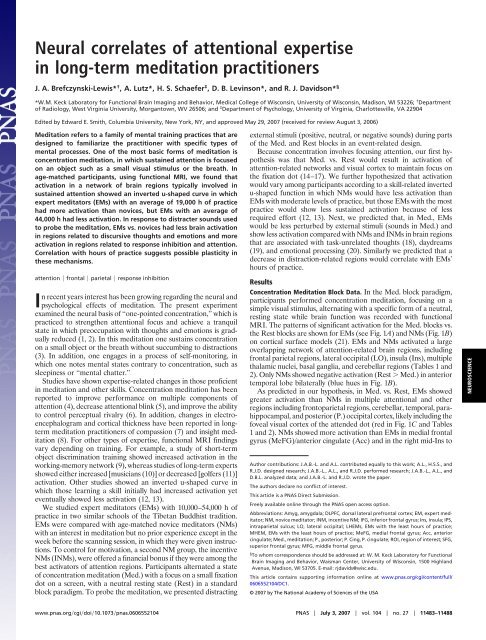
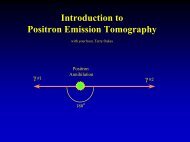
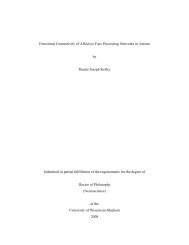
![[F-18]-L-DOPA PET scan shows loss of dopaminergic neurons](https://img.yumpu.com/41721684/1/190x146/f-18-l-dopa-pet-scan-shows-loss-of-dopaminergic-neurons.jpg?quality=85)
